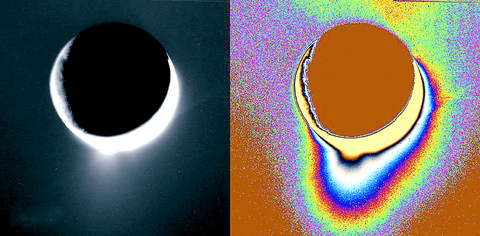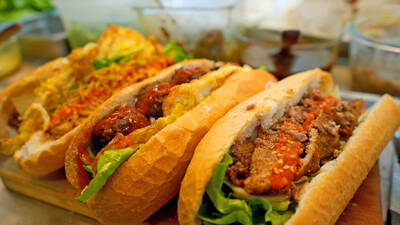ith newly discovered signs of liquid water, a moon of Saturn joins the small, highly select group of places in the solar system that could plausibly support life.
The moon, Enceladus, is only 400km wide, and planetary scientists expected that it would be nothing more than a frozen chunk of ice and rock. Instead, NASA's Cassini spacecraft has spotted eruptions of icy crystals, which hint at pockets of liquid water near the surface.
"It's startling," said Dr. Carolyn Porco of the Space Science Institute in Boulder, Colorado, leader of the imaging team for Cassini. Nine scientific papers about Enceladus appeared in Friday's issue of the journal Science. "I wouldn't be surprised see to the planetary community clamoring for a future exploratory expedition to land on the south polar terrain of Enceladus," said Porco, lead author of one of the Science papers. "We have found an environment that is potentially suitable for living organisms."

PHOTOS: NY TIMES NEWS SERVICE
Life requires at least three essential ingredients -- water, heat and carbon-based molecules -- and Enceladus may possess all three. As Cassini flew through the plumes of tiny ice crystals rising into space from the eruptions, it also detected simple carbon-based molecules like methane and carbon dioxide, which suggest more complicated carbon molecules might lie on the moon's surface.
The lack of a crater suggests that the heat is not the result of a meteor impact. Based on the initial observations, some scientists think that this warm region near the south pole may have somehow persisted for millions or billions of years, sufficient time for life to arise.
"It's an exciting place," said James Head, a professor of geological sciences at Brown University, who was not involved with any of the research reported in Science. "That's what exploration is all about. You go out there. It isn't A. It isn't B. It isn't C. It's D, none of the above."
Planetary scientists immediately started pointing to the discovery as an argument for preserving and continuing NASA's space science efforts. The agency's proposed budget would cut US$3 billion from space science over the next five years to help pay for the completion of the space station and plans to send astronauts back to the moon. NASA's astrobiology institute, which finances research on the possibility of life elsewhere in the solar system and universe, is to see its budget cut in half.
"They must now provide sufficient funds for NASA to conduct both human flight and robotic exploration missions," Porco said. "Right now, the funding is inadequate."
Cassini flew by Enceladus three times last year. For the first two fly-bys, Cassini's observations of the Enceladus' equatorial region turned up nothing odd -- except that it seemed to be deflecting Saturn's magnetic fields. That implied that Enceladus was somehow generating its own magnetic field.
NASA tweaked the trajectory of Cassini's July fly-by to pass within about 150km of Enceladus' surface. For the first time, the spacecraft got a look at the south pole, which turned out to be surprisingly smooth compared to the pockmarked northern hemisphere. And it was warm.
The expectation was that the temperature would be about -330? Fahrenheit. It turned out to be more than 100? warmer. "Which is fairly dramatic and blew us away when we first saw it," said John Spencer, a planetary scientist at the Southwest Research Institute in Boulder and a team member working with a Cassini instrument that measures infrared emissions. "It's a lot of heat to come out of such a tiny object."
Images of the moon also showed towering plumes of ice crystals coming off at high speed from the surface. The jets seem to originate from fissures near the south pole, Porco said.
Porco said their calculations eliminated the possibility that the particles were produced by warm vapor rising off warm ice at the surface. The best explanation, she said, is that pockets of liquid water exist under high pressure below a few tens of meters of ice. When the ice ruptures, the water shoots out and immediately freezes into ice crystals.
"We think we've got geysers," Porco said.
A small body like Enceladus would be unlikely to hold enough radioactive elements to produce continuing warmth. A more likely explanation is that the gravitational tugging on Enceladus by Saturn and another moon, Dione, squishes Enceladus, and that friction creates the heat. Another mystery is why the heat is concentrated around the south pole.

We lay transfixed under our blankets as the silhouettes of manta rays temporarily eclipsed the moon above us, and flickers of shadow at our feet revealed smaller fish darting in and out of the shelter of the sunken ship. Unwilling to close our eyes against this magnificent spectacle, we continued to watch, oohing and aahing, until the darkness and the exhaustion of the day’s events finally caught up with us and we fell into a deep slumber. Falling asleep under 1.5 million gallons of seawater in relative comfort was undoubtedly the highlight of the weekend, but the rest of the tour

Youngdoung Tenzin is living history of modern Tibet. The Chinese government on Dec. 22 last year sanctioned him along with 19 other Canadians who were associated with the Canada Tibet Committee and the Uighur Rights Advocacy Project. A former political chair of the Canadian Tibetan Association of Ontario and community outreach manager for the Canada Tibet Committee, he is now a lecturer and researcher in Environmental Chemistry at the University of Toronto. “I was born into a nomadic Tibetan family in Tibet,” he says. “I came to India in 1999, when I was 11. I even met [His Holiness] the 14th the Dalai

Following the rollercoaster ride of 2025, next year is already shaping up to be dramatic. The ongoing constitutional crises and the nine-in-one local elections are already dominating the landscape. The constitutional crises are the ones to lose sleep over. Though much business is still being conducted, crucial items such as next year’s budget, civil servant pensions and the proposed eight-year NT$1.25 trillion (approx US$40 billion) special defense budget are still being contested. There are, however, two glimmers of hope. One is that the legally contested move by five of the eight grand justices on the Constitutional Court’s ad hoc move

Stepping off the busy through-road at Yongan Market Station, lights flashing, horns honking, I turn down a small side street and into the warm embrace of my favorite hole-in-the-wall gem, the Hoi An Banh Mi shop (越南會安麵包), red flags and yellow lanterns waving outside. “Little sister, we were wondering where you’ve been, we haven’t seen you in ages!” the owners call out with a smile. It’s been seven days. The restaurant is run by Huang Jin-chuan (黃錦泉), who is married to a local, and her little sister Eva, who helps out on weekends, having also moved to New Taipei